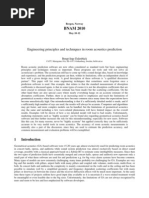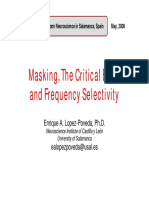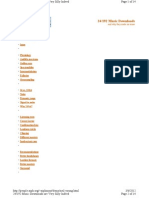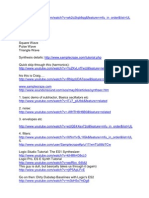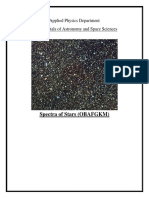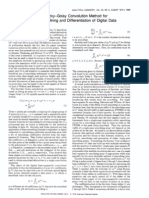Spectrograms
Uploaded by
Sonja GrbićSpectrograms
Uploaded by
Sonja GrbićA spectrogram is a visual representation of the spectrum of frequencies in a sound or other signal
as they vary with time or some other variable. The spectrogram is a basic tool in audio spectral
analysis and other fields. It has been applied extensively in speech analysis. The instrument that
generates a spectrogram is called a spectrograph/ spectrometer. A common format is a graph with
two geometric dimensions: the horizontal axis represents time the vertical axis is frequency! and
the third dimension indicates the amplitude of a particular frequency at a particular time which is
represented by the intensity or colour of each point in the image.
Identifying sounds in spectrograms
Let's look at how various kinds of sounds appear on a spectrogram.
Vowels
Vowels usually have very clearly defined formant bars, as in the following:
In dipthongs, you can see the formants change frequency as the tongue body moves
through the mouth:
ou can't always tell reliably which formant you're looking at !! "#, "$, "%, etc. !! unless
you already have a good idea of where to e&pect them. 'ut the e&istence of formants is
usually obvious enough that you can at least be sure you're looking at a vowel.
()here are some especially common difficulties in identifying formants. In , and
sometimes other back vowels, "# and "$ are often so close together that they appear as a
single wide formant band. In , "$ and "% also often appear merged together in a single
wide band.*
Fricatives
"ricatives are easy. )he turbulent airstream of fricatives creates a chaotic mi& of random
frequencies, each lasting for a very brief time. )he result sounds much like static noise, and
on a spectrogram it looks like the kind of static noise you might see on a )V screen.
+hile each momentary burst of energy occurs at a random frequency, there are tendencies
in which frequencies the random bursts cluster around. has a higher average frequency
than does, and both are higher than or .
Voiced fricatives show aspects of both regular vocal fold vibrations and a randomly
turbulent airstream.
[h]
-h. is really a voiceless version of the preceding or following vowel. /n a spectrogram, it
looks a little like a cross between a fricative and a vowel. It will have a lot of random noise
that looks like static, but through the static you can usually see the faint bands of the
voiceless vowel's formants.
Plosives
)he medial phase of a voiceless plosive is complete silence. /n a spectrogram, this will
appear as a white blank.
)he quiet vocal fold vibrations in a voiced plosive will sometimes appear as a faint band
along the bottom of the spectrogram at the frequency of f0. ('ut very often you won't see
anything there, either because the voicing got lost in the background noise or because the
recording or computer equipment cut off frequencies that low.*
)o tell the difference between plosives, listeners rely on the release burst and on formant
transitions. /n a spectrogram, the release burst looks like a very, very thin fricative. )he
formant transitions (if you can see them* look like the formants have been distorted away
from the frequencies they have during most of the vowel.
1spiration will look like a period of between the blank gap and the vowel !! specifically,
a voiceless version of the following vowel. (2ecall that the tongue body is in position for the
following vowel and that aspiration is 3ust a delay in the onset of voicing.*
4': 1spiration is not the same as the release burst. )he period of aspiration (which only
some voiceless plosives have* is much longer than the very short release burst (which all
released plosives have*.
)he above spectrogram is of the 5nglish word attack .
)he periods of time labelled are:
1: the initial schwa
': the medial phase of the (silence*
6: the release burst of the
7: the aspiration (delay of the onset of voicing for *
5:
the !! voicing has finally started. 2ight at the end of the vowel, you can see "$ and "%
start to approach one another in a formant transition pattern (often called the 8velar
pinch8* that usually marks the onset phase of a velar consonant.
": the medial phase of the (again, silence*
9:
the release burst of the (which I pronounced as released for the purposes of this
spectrogram*
Nasals and [l]
4asals and usually look like quite faint vowels, without a lot of amplitude in the higher
frequencies.
ou can still see some things that look like formants. 'ut the acoustic properties of tubes
with branches and side!chambers are much more complicated, with anti!formants as well
as formants, so the formant bands will appear in different positions and usually be fainter.
Which nasal or lateral it is usually isn't something you can figure out looking at 3ust a
spectrogram.
http://home.cc.umanitoba.ca/"#russll/phonetics/acoustic/spectrogram$sounds.html
You might also like
- Constructing Audio Effects With Digital Signal Processing - Yahia BOUASRIANo ratings yetConstructing Audio Effects With Digital Signal Processing - Yahia BOUASRIA6 pages
- (1972 Michael Gerzon) Synthetic Reverberation0% (1)(1972 Michael Gerzon) Synthetic Reverberation5 pages
- The Raven's Spiral Guide To Music Theory Version 0.8.1 (2012)100% (2)The Raven's Spiral Guide To Music Theory Version 0.8.1 (2012)100 pages
- Engineering Principles and Techniques in Room Acoustics PredictionNo ratings yetEngineering Principles and Techniques in Room Acoustics Prediction8 pages
- CD 442 Speech Science Spectrograms and Acoustic Analysis Lab Project InstructionsNo ratings yetCD 442 Speech Science Spectrograms and Acoustic Analysis Lab Project Instructions3 pages
- Micro-MIDI: A Real Time, Dynamic Microtonal MIDI Application100% (1)Micro-MIDI: A Real Time, Dynamic Microtonal MIDI Application7 pages
- Instant Download (Ebook PDF) Digital Audio and Acoustics For The Creative Arts by Mark Ballora PDF All Chapter100% (5)Instant Download (Ebook PDF) Digital Audio and Acoustics For The Creative Arts by Mark Ballora PDF All Chapter51 pages
- Memorials in St. Marys Graveyard and Church, Great MassinghamNo ratings yetMemorials in St. Marys Graveyard and Church, Great Massingham34 pages
- Music and Emotional Response Rough DraftNo ratings yetMusic and Emotional Response Rough Draft11 pages
- What Makes Us Like Music Determinants of Music Preference - Schäfer2010100% (1)What Makes Us Like Music Determinants of Music Preference - Schäfer201012 pages
- Download Full Teaching Music in American Society A Social and Cultural Understanding of Music Education Kelly PDF All Chapters100% (2)Download Full Teaching Music in American Society A Social and Cultural Understanding of Music Education Kelly PDF All Chapters55 pages
- Masking Frequency Selectivity and The Critical BandNo ratings yetMasking Frequency Selectivity and The Critical Band80 pages
- Impact of Intervals On The Emotional Effect in Western MusicNo ratings yetImpact of Intervals On The Emotional Effect in Western Music5 pages
- William M. Hartmann - How We Localize SoundNo ratings yetWilliam M. Hartmann - How We Localize Sound7 pages
- Vibrato Extraction and Parameterization PDFNo ratings yetVibrato Extraction and Parameterization PDF5 pages
- Otoacoustic Emissions As A Compositional Tool PDF100% (1)Otoacoustic Emissions As A Compositional Tool PDF3 pages
- Sound Reinforcement and Recording of Jazz and Large Ensembles - Practical and Easy To Use Basic and Advanced Ideas100% (1)Sound Reinforcement and Recording of Jazz and Large Ensembles - Practical and Easy To Use Basic and Advanced Ideas9 pages
- 24bit 192kHz Music Downloads and Why They Make No Sense - People - XiphNo ratings yet24bit 192kHz Music Downloads and Why They Make No Sense - People - Xiph14 pages
- Speak and Unspeak With P: by Paul Boersma and Vincent Van HeuvenNo ratings yetSpeak and Unspeak With P: by Paul Boersma and Vincent Van Heuven7 pages
- 10 Musical Ear Training Tips For The Adult BeginnerNo ratings yet10 Musical Ear Training Tips For The Adult Beginner9 pages
- Music Genre List - A Complete List of Music Styles, Types and GenresNo ratings yetMusic Genre List - A Complete List of Music Styles, Types and Genres14 pages
- Orkshop On Acoustic Voice Analysis: Summary StatementNo ratings yetOrkshop On Acoustic Voice Analysis: Summary Statement36 pages
- A Paradigm For Physical Interaction With Sound in 3-D Audio SpaceNo ratings yetA Paradigm For Physical Interaction With Sound in 3-D Audio Space9 pages
- Stability Space and The Below-N Threshold: A Computational Approach To Music Analysis100% (1)Stability Space and The Below-N Threshold: A Computational Approach To Music Analysis8 pages
- Understanding Down Syndrome As An InterferonopathyNo ratings yetUnderstanding Down Syndrome As An Interferonopathy34 pages
- Acoustic Measurements On Prosody Using Praat: Bert RemijsenNo ratings yetAcoustic Measurements On Prosody Using Praat: Bert Remijsen70 pages
- Hydrophone: Detect Sound Waves and Other Pressure Waves100% (1)Hydrophone: Detect Sound Waves and Other Pressure Waves12 pages
- Andrew Janca Et Al - Emission Spectrum of Hot HDO Below 4000 CM - 1No ratings yetAndrew Janca Et Al - Emission Spectrum of Hot HDO Below 4000 CM - 14 pages
- Models - Sme.building Response SpectrumNo ratings yetModels - Sme.building Response Spectrum28 pages
- 2005 Ground Vibration Due To Dynamic CompactionNo ratings yet2005 Ground Vibration Due To Dynamic Compaction10 pages
- Pesticides MRL Guidelines Wrkdoc 2017-11813No ratings yetPesticides MRL Guidelines Wrkdoc 2017-1181346 pages
- Comments On The Savitzky Golay Convolution Method For Least Squares Fit Smoothing and Differentiation of Digital DataNo ratings yetComments On The Savitzky Golay Convolution Method For Least Squares Fit Smoothing and Differentiation of Digital Data4 pages
- PVP2006-ICPVT-11-93732: Seismic Analysis of A Pressure VesselNo ratings yetPVP2006-ICPVT-11-93732: Seismic Analysis of A Pressure Vessel8 pages
- Spectro Xsort: Handheld XRF SpectrometersNo ratings yetSpectro Xsort: Handheld XRF Spectrometers4 pages
- Protein Sequencing and Identification by Mass SpectrometryNo ratings yetProtein Sequencing and Identification by Mass Spectrometry55 pages
- A Practical Method For Design of CoastalNo ratings yetA Practical Method For Design of Coastal11 pages
- R&S®ADD557SR Direction Finding and Monitoring AntennaNo ratings yetR&S®ADD557SR Direction Finding and Monitoring Antenna6 pages
- Constructing Audio Effects With Digital Signal Processing - Yahia BOUASRIAConstructing Audio Effects With Digital Signal Processing - Yahia BOUASRIA
- The Raven's Spiral Guide To Music Theory Version 0.8.1 (2012)The Raven's Spiral Guide To Music Theory Version 0.8.1 (2012)
- Engineering Principles and Techniques in Room Acoustics PredictionEngineering Principles and Techniques in Room Acoustics Prediction
- CD 442 Speech Science Spectrograms and Acoustic Analysis Lab Project InstructionsCD 442 Speech Science Spectrograms and Acoustic Analysis Lab Project Instructions
- Micro-MIDI: A Real Time, Dynamic Microtonal MIDI ApplicationMicro-MIDI: A Real Time, Dynamic Microtonal MIDI Application
- Instant Download (Ebook PDF) Digital Audio and Acoustics For The Creative Arts by Mark Ballora PDF All ChapterInstant Download (Ebook PDF) Digital Audio and Acoustics For The Creative Arts by Mark Ballora PDF All Chapter
- Memorials in St. Marys Graveyard and Church, Great MassinghamMemorials in St. Marys Graveyard and Church, Great Massingham
- What Makes Us Like Music Determinants of Music Preference - Schäfer2010What Makes Us Like Music Determinants of Music Preference - Schäfer2010
- Download Full Teaching Music in American Society A Social and Cultural Understanding of Music Education Kelly PDF All ChaptersDownload Full Teaching Music in American Society A Social and Cultural Understanding of Music Education Kelly PDF All Chapters
- Masking Frequency Selectivity and The Critical BandMasking Frequency Selectivity and The Critical Band
- Impact of Intervals On The Emotional Effect in Western MusicImpact of Intervals On The Emotional Effect in Western Music
- Sound Reinforcement and Recording of Jazz and Large Ensembles - Practical and Easy To Use Basic and Advanced IdeasSound Reinforcement and Recording of Jazz and Large Ensembles - Practical and Easy To Use Basic and Advanced Ideas
- 24bit 192kHz Music Downloads and Why They Make No Sense - People - Xiph24bit 192kHz Music Downloads and Why They Make No Sense - People - Xiph
- Speak and Unspeak With P: by Paul Boersma and Vincent Van HeuvenSpeak and Unspeak With P: by Paul Boersma and Vincent Van Heuven
- 10 Musical Ear Training Tips For The Adult Beginner10 Musical Ear Training Tips For The Adult Beginner
- Music Genre List - A Complete List of Music Styles, Types and GenresMusic Genre List - A Complete List of Music Styles, Types and Genres
- Orkshop On Acoustic Voice Analysis: Summary StatementOrkshop On Acoustic Voice Analysis: Summary Statement
- A Paradigm For Physical Interaction With Sound in 3-D Audio SpaceA Paradigm For Physical Interaction With Sound in 3-D Audio Space
- Stability Space and The Below-N Threshold: A Computational Approach To Music AnalysisStability Space and The Below-N Threshold: A Computational Approach To Music Analysis
- Understanding Down Syndrome As An InterferonopathyUnderstanding Down Syndrome As An Interferonopathy
- Acoustic Measurements On Prosody Using Praat: Bert RemijsenAcoustic Measurements On Prosody Using Praat: Bert Remijsen
- Hydrophone: Detect Sound Waves and Other Pressure WavesHydrophone: Detect Sound Waves and Other Pressure Waves
- Andrew Janca Et Al - Emission Spectrum of Hot HDO Below 4000 CM - 1Andrew Janca Et Al - Emission Spectrum of Hot HDO Below 4000 CM - 1
- Comments On The Savitzky Golay Convolution Method For Least Squares Fit Smoothing and Differentiation of Digital DataComments On The Savitzky Golay Convolution Method For Least Squares Fit Smoothing and Differentiation of Digital Data
- PVP2006-ICPVT-11-93732: Seismic Analysis of A Pressure VesselPVP2006-ICPVT-11-93732: Seismic Analysis of A Pressure Vessel
- Protein Sequencing and Identification by Mass SpectrometryProtein Sequencing and Identification by Mass Spectrometry
- R&S®ADD557SR Direction Finding and Monitoring AntennaR&S®ADD557SR Direction Finding and Monitoring Antenna



